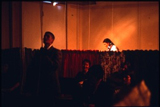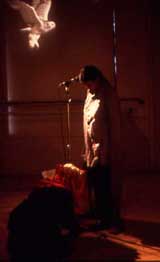Realms of Habitation
|
An essential part of McKeough’s approach is the reconfiguration of the familiar – everyday objects, materials and gestures presented in ways that expose a truth about the habitats we take for granted. In Dancing on a Plate (1996), for example, household articles suspended from the ceiling functioned as a literal representation of a life “up in the air”, its future dependent on a decision of whether to leave a relationship and, by extension, the physical domestic space in which that relationship resides. In the performance that took place within the installation, two pairs of dancers mimicked the paths of ropes through a knot in a “slow decision-making dance” (McKeough, 18/May/2006). The installation’s spring-loaded floor triggered recordings of the artist intoning a grave square-dance call accompanied by haunting vocalizations by Kathleen Yearwood and the percussive clicking of a step dancer. These directives were also followed by a third couple, locked in a confrontational dance at a kitchen table at the centre of the space. The co-existent rhythms of the two dances echoed the tenuous internal balance required of the inhabitants of this unstable emotional territory – the essence of the square dance is timing and cooperation, while the key to the step-dance is not to wander from one’s place and to remain stoic while exerting tremendous effort.
McKeough explored the instability of different type of transitional in Outskirts (2003). This complex installation depicted, in a series of kinetic and auditory vignettes, an anthropomorphized forest’s futile strategies of resistance towards encroaching development, and a subdivision’s uneasy existence at the edge of town. To one side of a roadway, trees have rebuilt themselves from lumber and Sonotube, and fling cigarette butts back towards the town. Swaying grass has mutated into tiny ladders and a feeble wind, generated by oscillating fans, rustles shopping bags trapped in a chain-link fence. Four box-like houses are aligned along the opposite side of the road. Behind each prim door is a showcase of the aberrant hybrids produced by these overlapping worlds: In the forest-green Skunk Room, a lawn mower sputters and growls struggles against a chain that secures it to a wall and prevents it from carrying out its work of laying a white stripe down the centre of the black fake fur rug. In the Raccoon Room, two faucets run, unattended – an unmistakable sign of waste. The space is suffused with the stifling perfume of Ivory soap emanating from the countless teeth carved from it that litter the floor, and the equally unsettling sounds of panting and creature voices complaining “oh, no, it’s way, way too hot…” The door of the Porcupine Room opens to reveal a pair of furry disembodied feet of uncertain animal origin marching atop a faux-rustic dining room table while a gloomy creature’s voice murmurs, “throw it away”. The Cat room’s eponymous pet, meanwhile, is nowhere to be seen. It has been driven into hiding by the absurd mechanical puppies that share its space, but its shrill pleas for egress go unheeded. |
  |
